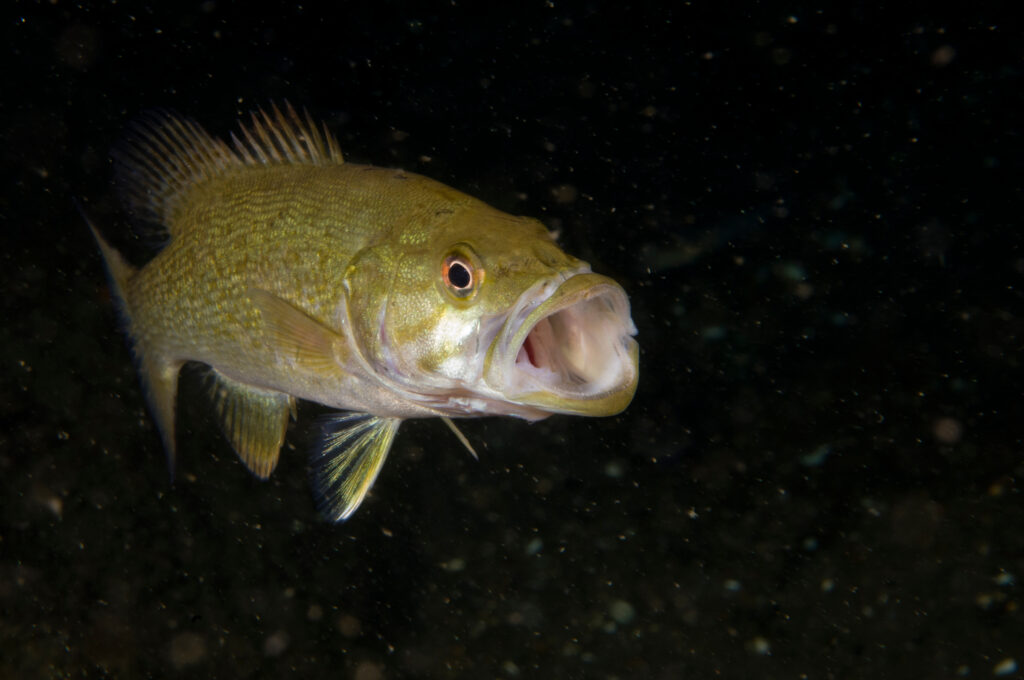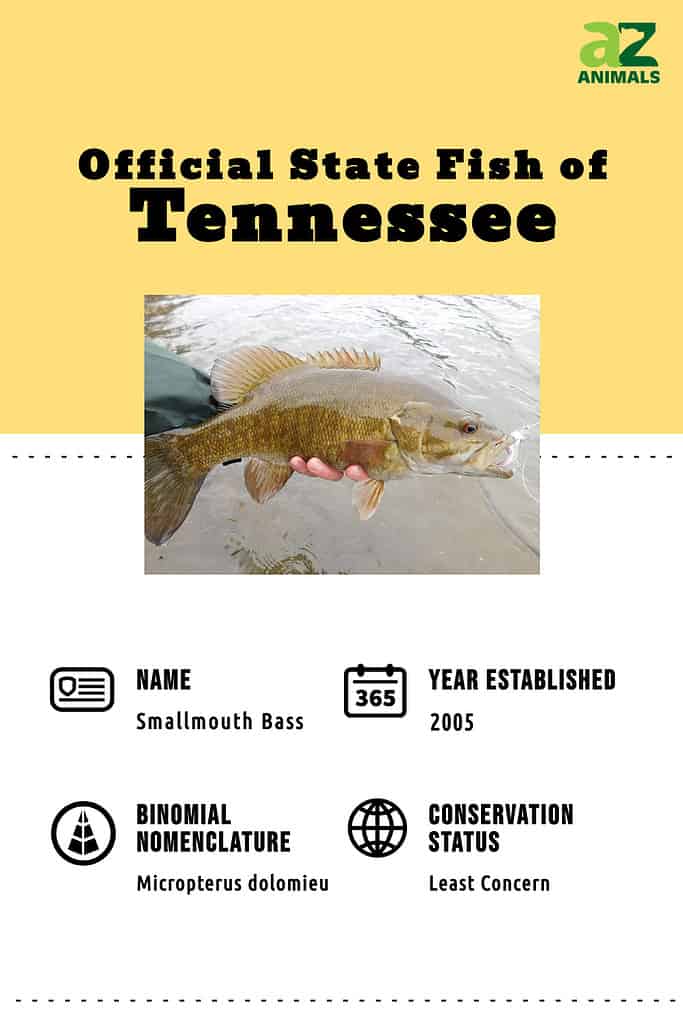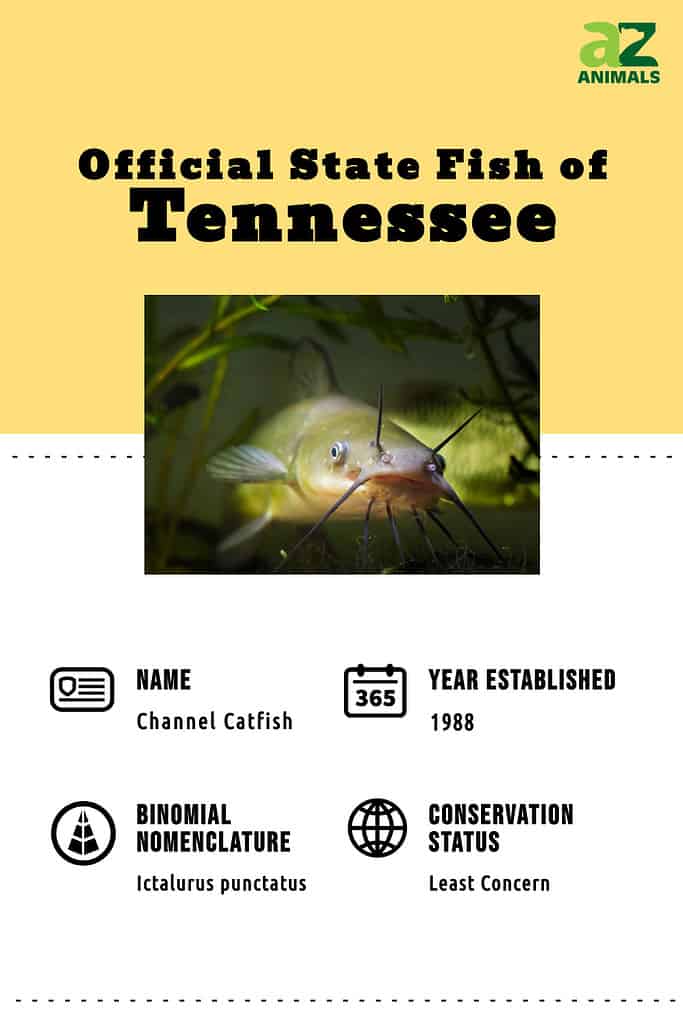Tennessee has two official state fish: the smallmouth bass (Micropterus dolomieu) and the channel catfish (Ictalurus punctatus).
About the Smallmouth Bass
The smallmouth bass is the official sport fish of Tennessee. This fish was made an official state fish of Tennessee in 2005. Today, it is one of the most popular fish that anglers seek to catch – across the entire United States! However, Tennessee is known for being one of the best places to fish for smallmouth bass in the country. The average smallmouth bass weighs between 2 and 6 pounds. However, the largest record-setting smallmouth bass ever caught in Tennessee weighed a whopping 11 pounds and 15 ounces!
The smallmouth bass is a freshwater fish and one of the most popular game fish species in North America. These fish are members of the sunfish family and one of six different black bass species. They live throughout many regions of the United States. This includes Tennessee and other tropical and temperate regions. They can grow to reach as big as 12 pounds and up to 30 inches long.
Smallmouth bass have three brown vertical bands on their sides, which tend to be black, green or brown in color. The smallmouth bass also has a dorsal find that is notched, but not as substantially as that found on largemouth bass.
These carnivorous predators will eat any small creature that they can swallow. Their diet consists of everything from minnows to crayfish and zooplankton or aquatic insects. They are a daytime feeder but will hunt mostly at night during the summer. Smallmouth bass live between 6 to 14 years on average. However, there have been recorded species determined to be 20 years old.

The Smallmouth bass is one of the two official state fish of Tennessee. It is also one of the most popular sport fish species in the country.
©K Steve Cope/Shutterstock.com
About the Channel Catfish
The channel catfish is the official commercial fish of Tennessee. This fish was made an official state fish of Tennessee in 1988. The channel catfish is a whiskered bottom feeder that became the commercial state fish of Tennessee due to its importance in fish farming as a major source of food and economic good. These fish can get very large and the largest specimens can be as large as 40 and 50 pounds. In fact, the largest channel catfish ever recorded in the state of Tennessee weighed a gigantic 41 pounds and was caught on July 30, 1982. This fish was an incredible 54 inches long. The world record weight for a channel catfish is 58 pounds and was set in South Carolina in 1964. These fish are also one of the most commonly-caught fish in North America.
The channel catfish is a freshwater fish that are among the most numerous catfish species in North America. These fish usually have gray-blue sides, black backs, and white bellies. Though rare, some channel catfish can be albino and have a peach coloration. This is a recessive gene, but some catfish have been bred to carry this gene so that people can see them in aquariums or swimming in ornamental garden ponds. These bottom-dwelling omnivores troll the dark and muddy waters to eat aquatic insects, algae, and plants. Channel catfish typically live to be up to 15 years old.

The channel catfish is one of two official state fish of Tennessee and are plentiful throughout the state’s waters.
©Aleron Val/Shutterstock.com
Where to Find Tennessee’s State Fish
Smallmouth Bass
To catch smallmouth bass in Tennessee, consider visiting cities like Chattanooga, Dale Hollow Lake, Kentucky Lake, or the Pickwick Lake and Wilson Lake area. Chattanooga is a vibrant city on the Georgia/Tennessee border, which offers the Tennessee River, Chickamauga Lake, and Nickajack Lake, where there are plentiful largemouth bath, catfish, striped bass, bluegill, crappie, and one of the official state fish of Tennessee, the smallmouth bass. Dale Hollow Lake is further away at the Kentucky/Tennessee border, where the record for smallmouth bass was set. The other locations each have tremendous opportunities for smallmouth bass fishing and all other manner of water sports – Kentucky Lake is among the largest human-made lakes in the world and provides 2,380 miles of shoreline!
Smallmouth bass prefer clearer water and does not weather pollution very well. In general, they tend to inhabit streams, reservoirs, and lakes with relatively cooler temperatures and rocky areas.
Catching smallmouth bass can be a good thing for the environment! Though they are a popular sport fish because they can grow to a large size and are fighters on the fishing line, these predators can negatively impact other native species of fish.

Smallmouth bass are carnivorous fish who eat small fish, insects, crustaceans, and other aquatic organisms.
©RLS Photo/Shutterstock.com
Channel Catfish
Channel catfish are plentiful throughout Tennessee and can be found in the majority of major lakes and water reservoirs in the state. However, some of the best places to fish for catfish, which are known for the plentiful fish in their waters, are Reelfoot Lake, Old Hickory Lake, J. Percy Priest Lake, Woods Lake, and Douglas Lake. Because these are such big fish, typically weighing between 20 and 40 pounds, many anglers flock to try their strength and pull in one of these big, powerful catches.
Look for these bottom-dwellers in the murky, muddy waters of lakes and ponds. You may find them living in pockets of deeper water, though they will move into shallow water to feet at night.

Channel catfish like to live in deeper water from 10 to 30 feet deep, but will swim into shallow water to feed on plants and insects.
©Brookieland/Shutterstock.com
How to Catch the State Fish of Tennessee
Smallmouth Bass
Regardless of where you fish, look for rocky areas, gravel beds, reefs, and rock-studded shorelines. Use lures like ¼-ounce spinnerbaits and buzz baits or plastic lures, or you can use live insect larvae, crayfish, or small fish to attract the hungry smallmouth bass. Smallmouth bass are active early in the day, from first light until mid-morning. They take a mid-day break and then become active again starting in the late afternoon when the sun starts to go down.
Smallmouth bass usually inhabit shallow water zones, especially in sandy or gravelly areas where they spawn. During the early spring, look in these areas. Later in the summer, you may only find smaller smallmouth bass in the shallows at the middle of the day. However, stick around, and you will see the bigger fish come back to the shallower area to eat small fish like minnows, or crayfish, later in the evening and into the early morning light.
Once you catch smallmouth bass, you will find that these fish can make a tasty meal! They have mild-flavored meat that can be used in many different recipes.
Channel Catfish
If you are interested in fishing for channel catfish, you can find some of the best catfishing from the lakesides and riverbanks of Tennessee, from going out on a boat or casting in from a dam. Depending on how you plan to fish, you may choose a different lake or river in Tennessee. Watts Bar Tailwater has abundant catfish in the tailwaters of the Tennessee River and is a great location for fishing from the riverbanks. Reelfoot Lake can be navigated by shallow, aluminum boats but not easily by larger boats, since its catfish live among old tree stumps underwater. You could navigate Douglas Lake using a johnboat or other aluminum boat, which will take you across the rocky shoals. They are present throughout the warmer months of the year and may bite chicken liver, gizzard shad, or skipjack bait.


The photo featured at the top of this post is © Brookieland/Shutterstock.com
Thank you for reading! Have some feedback for us? Contact the AZ Animals editorial team.







